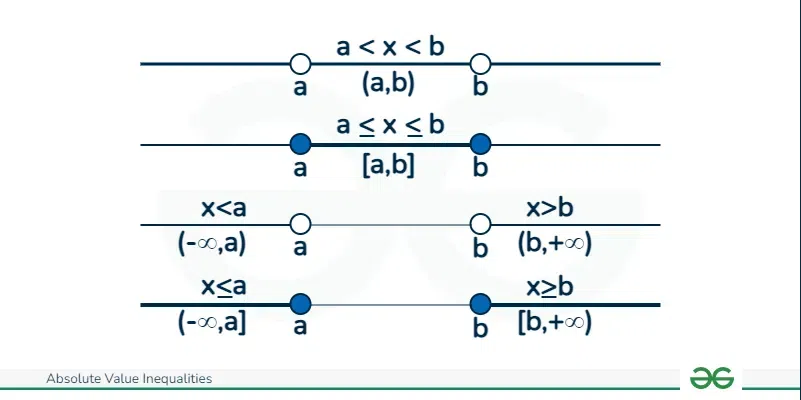
|
|
Inequalities that involve algebraic expressions with absolute value symbols and inequality symbols are called Absolute Value Inequality. In this article, we will discuss inequalities and absolute value inequalities and others in detail. Table of Content What is Inequalities?Inequalities can be understood as the complement of equations. Inequalities are used to establish a relationship between two or more mathematical values based on the unequal relationship between them. Let us look at an example
The above relationship indicates that x is not equal to y+5 rather it is greater than the value of y after 5 is added to it. What is Absolute Value Inequalities?Absolute Value Inequalities are a subcategory of inequalities that compare absolute values of mathematical quantities. These usually include symbols like >, < which denote unequal relationships. What is Absolute Value?Let us see the formal definition
We can categorize the inequality into two major types:
Each of the given types is denoted using different symbols which will be discussed later. Example of Absolute Value InequalitiesHere are some examples to understand the Absolute Value Inequalities
Solving Absolute Value InequalitiesWe use number line approach to solve an inequality and follow the steps added below:
Graphical Representation of InequalitiesWe can use a graph to plot the inequalities and find the corresponding solution for the inequalities. Let us see how we can use the graph to plot the solution
Here is the representation of different cases:  Representation of Inequalities Types of Absolute Value InequalitiesDepending on the type of sign in the inequality, there are different types of inequalities which are mentioned below:
Inequalities with Greater Than ConditionThese inequalities generally use a greater than sign i.e. the number is greater than the value of some other mathematical value. Here are some examples of such inequalities
Inequalities with Less Than ConditionThese inequalities generally use a less-than sign i.e. the number is less than the value of some other mathematical value. Here are some examples of such inequalities
Compound Inequalities Involving Absolute ValuesAs the name suggests, Compound Inequalities involve both greater than and less than cases i.e. the number is less than and greater than the value of some other mathematical value. These inequalities use the absolute value. Here are some examples of such inequalities
Intersection and Union in Absolute Value InequalitiesLet us understand how we can take Intersection and Union in Absolute Value Inequalities. Union of InequalitiesFor a given set of values, if the inequality is x>=a or x<b then we need to find the union of the values of x which can be given by Case 1: x >= a or x < b {x: x < b U x ≥ a} Case 2: x < a or x >= b {x: x <a U x ≥ b} = {x: x < a}∪{x: x ≥ b}. The solution i.e. the union can be calculated using graph. Consider the example x <= 3 || x >= -4 , then the union of the inequalities will give an overlapping interval which will include all real numbers as shown below.  Union of Inequalities Intersection of InequalitiesFor a given set of values, if the inequality is x >= a and x < b then we need to find the intersection of the values of x which can be given by Case 1: a <= x < b {x: a≤x < b} Case 2: a <= x U b > x {x: a ≤ x U x < b} The solution i.e. the intersection can be calculated using graph. Consider the example x <= 4 U x >= -5 , then the intersection of the inequalities will give an interval which will include all real numbers from -5 and 4 as shown below.  Intersection of Inequalities Read More: Examples on Absolute Value InequalitiesExample 1: Solve for inequality |x+24|>-5 using the formula-based approach. Solution:
Example 2: Solve this less than equal to absolute inequality |y + 5| <= 3y Solution:
Practice Problems on Absolute Value InequalitiesP1. Use the union and intersection method to find the solution for x given |x+7|<1001 and |x+2|>24. P2. Use the graphical representation method to find the solution of |2x+5|+y>7x P3. Solve the inequality ∣2x + 3∣ < 5. P4. Find all values of such that ∣x − 4∣ ≥ 2. FAQs Absolute Value InequalitiesWhen do we use curved and square brackets while writing the solution of inequality?
What are the equivalents of curved and square brackets in graphical representation?
When is the sign switched from negative to positive and vice-versa in an inequality?
Can an absolute value inequality be negative?
|
Reffered: https://www.geeksforgeeks.org
| Mathematics |
| Related |
|---|
| |
| |
| |
| |
| |
Type: | Geek |
Category: | Coding |
Sub Category: | Tutorial |
Uploaded by: | Admin |
Views: | 16 |